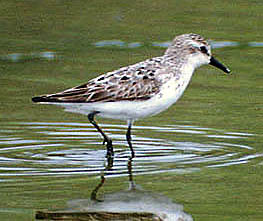

Both of these birds were photographed near Ventura, California. The shorebird was 29 Aug. 1993 and the tern 4 Oct. 1997. Photos © by Don DesJardin. All rights reserved.
As pointed out in comments, Forster's Tern is eliminated by the tail pattern. Forster's shows white outer webs with gray on the inner webs and sometimes the tips. Common/Arctic show dark on the outer webs as seen here. The choice between Common and Arctic may be more difficult. One feature useful in the hand, is the length of the the white tongues on the outermost primaries. These are longer on Arctic, reaching almost to the tip of the feather. On Common, these tongues are shorter and the resulting black tips to the outer primaries is much broader as seen here. The darker gray on the secondaries forming a faint bar above is also better for Common Tern than for Arctic which usually has all white secondaries. I've seen dark carpal bars on both species and I think that mark may be overrated. Much touted is the translucence to the underwings. On Arctic all the primaries appear translucent from below forming a pattern recalling Bonaparte's Gull. On Common only the innermost primaries are translucent, forming a pattern more like Sabine's Gull. Here all the primaries appear somewhat translucent, but this is an artifact of the way the feathers are spread. We are seeing translucence only on the white tongues on the inner webs. This pattern best fits Common.
Attempting to age these terns is more difficult. I think the best discussion of tern identification is the paper by Claudia Wilds (Birding 25:94-108, 1993). Knowing that the tern was photographed in early October, and having already identified it as a Common Tern, my interpretation of the chart of page 107 of this article is that the bird has completed primary molt and is close to Basic II.
The peep is mostly in basic-like plumage but appears to have retained a few dark centered scapulars indicating molt. Don DesJardin felt it was an adult, and I tend to agree. Adult Semiplamated Sandpipers are very scarce along the West Coast after early July while juveniles persist through mid-September so this is an unusual bird indeed! Also I believe that juvenile Semipalmated Sandpipers don't normally molt until they reach their wintering grounds so we would not expect juveniles to be in molt in California. The rather dumpy appearance and short thick-set bill are strongly indicative of Semipalmated Sandpiper, but this is a plumage seldom encountered in California and very tricky to identify. The possibility of Red-necked Stint should be considered, and I'm not certain how to completely eliminate it without a better view of the toes. Winter plumage Red-necked Stint usually shows a whiter forehead than what we see here, and a somewhat more attenuated bill shape. However, the rather long primary projection on the mystery bird is suggestive of a stint. Western Sandpiper usually appears to have a smaller eye as well as a longer bill with a finer tip than the mystery bird. Also note the darker cap, which I think is more typical of Semipalmated Sandpiper than of other contenders.
Sanderling is eliminated by the rear toe, but without direct size comparison, photos may be confusing. There is a notorious case of a breeding plumage Sanderling which was nearly accepted as the first British record of Red-necked Stint until it was pointed out that the bird was actually a Sanderling as evidenced by the lack of a rear toe.
The original images are below:
 |
 Both of these birds were photographed near Ventura, California. The shorebird was 29 Aug. 1993 and the tern 4 Oct. 1997. Photos © by Don DesJardin. All rights reserved. |
Color perception has been a chronic problem in assessing photographic images on the web. This problem is compounded by the wide variety of hardware and software used to view these images. Please adjust your video to the highest possible number of colors. My logs show that over 25% of visitors view these pages with only 256 colors (8 bit). Sixteen bit (high color) is minimum and 24 bit (true color) desirable. Also you may wish to calibrate your monitor against a color standard such as http://www.microimagevideo.com/technical/colorbars.html and ensure that brightness and contrast are set correctly.